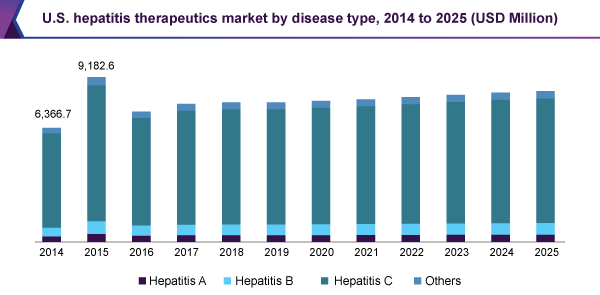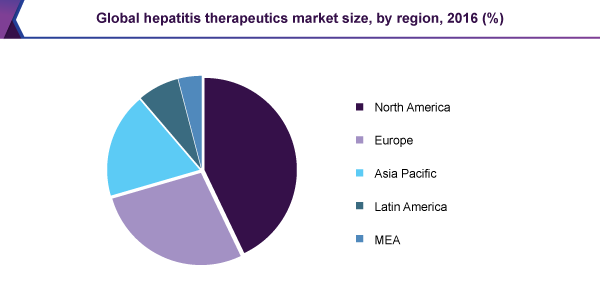- Home
- »
- Pharmaceuticals
- »
-
Hepatitis Therapeutics Market Size, Share, Industry Report, 2018-2025GVR Report cover
![Hepatitis Therapeutics Market Size, Share, And Trend Report]()
Hepatitis Therapeutics Market Size, Share, And Trend Analysis By Disease Type (Hepatitis A, B, C) By Region (North America, Europe, APAC, Latin America, MEA), And Segment Forecasts, 2018 - 2025
- Report ID: GVR-1-68038-449-9
- Number of Report Pages: 80
- Format: PDF, Horizon Databook
- Historical Range: 2014 - 2016
- Forecast Period: 2017 - 2025
- Industry: Healthcare
Report Overview
The global hepatitis therapeutics market size was estimated at USD 19.6 billion in 2016 and is anticipated to grow at a CAGR of 2.7% during the forecast period. Few prominent factors that are expected to boost the market are growing prevalence of viral hepatitis, rise in the number of autoimmune diseases, and the surge in healthcare expenditures across the globe. In 2015, approximately 1.34 million people died due to this condition globally. This number is significantly high to be compared with the number of deaths caused by HIV and tuberculosis.

However, the number of deaths owing to HIV and tuberculosis is declining, while the rate of deaths owing to viral hepatitis is witnessing an upward trend. This condition is the inflammation of liver tissue caused due to excessive alcohol consumption, medication errors, viral infection, autoimmune diseases, toxins, and nonalcoholic steatohepatitis. According to the WHO, nearly 1.4 million people die every year globally due to this disease, and approximately 400 million people are infected with at least one form of hepatitis.
This condition is generally classified into two types based on the duration for which the patient suffers. If the condition lasts for less than six months, then it is classified as acute, when the condition persists for more than six months, then it is a case of a chronic condition. On the basis of disease type, the hepatitis therapeutics market is segmented into A, B, C, and others.
The others segment covers the market estimates for hepatitis D and E, which occur rarely compared to the other three conditions. HAV spread through intake of contaminated water, food, or through direct contact with an infected person. According to the estimates of WHO, approximately 90% of children in developing economies have been infected with the virus before reaching 10 years of age owing to poor hygiene & sanitary conditions.
The access to treatments of this disease has been limited to people who have a high-income level owing to high drug prices, which might act as a restraining factor for this market. The introduction of generic versions of HCV drugs has changed the market dynamics across the world. With more people being able to afford the generic versions, the usage rates of its drugs are expected to grow rapidly over the next few years.
Disease Type Insights
Hepatitis B Virus (HBV) infects the liver and can lead to chronic & acute liver disease. As per the WHO, an estimated 240 million people have chronic hepatitis B and more than 686,000 people die every year due to complications arising from it. The virus can be transmitted through blood and other body fluids of an infected person. The market was valued at USD 2.6 billion in 2016 and held the second-largest revenue share owing to the high prevalence of hepatitis B.
The Hepatitis D Virus (HDV) needs the help of HBV to replicate & proliferate in the body. HDV is a Ribonucleic Acid virus. Globally, around 15 million people are co-infected with HDV & HBV and presently no effective medication is available for HDV. Therefore, immunization against HBV is strongly recommended to prevent both hepatitis B and D. This is one of the key factors responsible for the current revenue share of the market.

As compared to hepatitis A and B, HCV leads to various serious complications. According to the WHO estimates, globally approximately 130 to 150 million people are infected by HCV. In addition, a significant number of HCV infected patients develop liver cancer or liver cirrhosis and nearly 700,000 people die due to these conditions. The aforementioned factor is driving demand for HCV drugs over the forecast period.
The introduction of technologically advanced therapeutic products for the treatment of hepatitis has been a major driver for growth. Earlier hepatitis C was not curable, but with the introduction of products such as Sovaldi and Harvoni, in 2013 and 2014 respectively, the treatment rate has significantly increased over the past few years. In 2015, these products reportedly had over USD 19.1 billion sales and the demand for these drugs is expected to remain strong over the next few years.
Regional Insights
The hepatitis therapeutics market is mainly dominated by North America followed by Europe and Asia Pacific. In 2016, the North America market accounted for 42.9% of revenue mainly due to the high demand in the U.S., relatively higher affordability of patient population, and awareness pertaining to advance therapeutics in the region. The presence of well-developed healthcare infrastructure, reimbursement, and access to most innovative medicines are some of the crucial factors contributing to the high share.
The Asia Pacific market is expected to witness the fastest growth rate of 5.8% over the forecast period. High disease burden, growing access to medicines, improvement in healthcare & sanitation, and rising awareness about the hepatitis vaccination are expected to positively reinforce the growth prospects in the region. For instance, countries such as India, China, Indonesia, and other South Asian economies are constantly increasing their healthcare expenditure and reimbursement coverage to help more people avail quality healthcare services.
Moreover, the growing demand for generic drugs is also anticipated to boost the Asia Pacific region. Gilead has licensed 7 Indian manufacturers to supply some of the hepatitis drugs to different parts of the world. The countries covered as a part of this deal include more than 50% of the HCV infected population. The various license negotiated by the Medicine Patent Pool enables various manufacturer to launch generic version of these HCV drugs even while the drugs are patented, which is further expected to impact the market over the forecast period, with declining drug price and increase in consumption rate.
However, MEA and Latin America are also anticipated to witness strong growth due to the high prevalence rates and rise in the import of generic medicines to treat different hepatitis conditions. As the patient population in the U.S. and other developed regions is declining due to the positive results of using HCV drugs, different manufacturers are expanding their businesses in MEA and Latin America regions to cater to the high unmet needs for better treatment.
TABLE 1 Medicines or combination medicines that were approved, 2013-2016
Medicine Name
Brand Name
Approval Year
Sofosbuvir
Sovaldi
2013
Sofosbuvir/Ledipasvir
Harvoni
2014
Dasabuvir/Ombitasvir/Paritaprevir/Ritonavir
Viekira Pak
2014
Daclatasvir
Daklinza
2015
Ombitasvir/Paritaprevir/ Ritonavir
Technivie
2015
Elbasvir/Grazoprevir
Zepatier
2016
Sofosbuvir/Velpatasvir
Epclusa
2016
Source: U.S.FDA
Hepatitis Therapeutics Market Share Insights
Players such as Gilead; Johnson & Johnson; Bristol-Myers Squibb Company; Merck & Co., Inc.; and AbbVie Inc. majorly dominate the global hepatitis therapeutics industry. There are several generic manufacturers who are expanding their operations to cater to the high unmet needs of hepatitis patients in Asia Pacific, Latin America, and the Middle East region.
Growing healthcare costs coupled with the decline in R&D activities and Medicare budgets are some of the key factors affecting the profitability of players and impact the market dynamics to a great extent. The growing awareness pertaining to the availability of generic drugs is also expected to increase the treatment rate and improve overall healthcare outcomes.
Another key factor affecting the market growth is the adoption of different pricing models by manufacturers in various parts of the world. In the U.S., the prices are market-driven, whereas, in countries such as the U.K. and Germany, the government agencies negotiate the prices to maintain affordability and ensure equilibrium between demand and supply. In some other countries, the governments also regulate the prices using price caps, tenders, and other incentives.
Hepatitis Therapeutics Market Report Scope
Report Attribute
Details
Market size value in 2020
USD 22.5 billion
Revenue forecast in 2025
USD 25.8 billion
Growth Rate
CAGR of 2.7% from 2017 to 2025
Base year for estimation
2016
Historical data
2014 - 2016
Forecast period
2017 - 2025
Quantitative units
Revenue in USD Million and CAGR from 2017 to 2025
Report coverage
Revenue forecast; company share; competitive landscape; growth factors and trends
Segments covered
Disease type, region
Regional scope
North America; Europe; Asia Pacific; Latin America; MEA
Country scope
U.S.; Canada; Germany; U.K.; China; India; Brazil; Mexico; South Africa
Key companies profiled
Gilead; Johnson & Johnson; Bristol-Myers Squibb Company; Merck & Co., Inc.; AbbVie Inc.
Customization scope
Free report customization (equivalent up to 8 analysts working days) with purchase. Addition or alteration to country; regional & segment scope.
Pricing and purchase options
Avail customized purchase options to meet your exact research needs. Explore purchase options
Segments Covered in the ReportThis report forecasts revenue growth at global, regional & country levels and provides an analysis of the industry trends in each of the sub-segments from 2014 to 2025. For the purpose of this study, Grand View Research has segmented the global hepatitis therapeutics market report on the basis of disease type and region:
-
Disease Type Outlook (Revenue, USD Million, 2014 - 2025)
-
Hepatitis A
-
Hepatitis B
-
Hepatitis C
-
Others
-
-
Regional Outlook (Revenue, USD Million, 2014 - 2025)
-
North America
-
The U.S.
-
Canada
-
-
Europe
-
Germany
-
The U.K.
-
-
Asia Pacific
-
China
-
Japan
-
-
Latin America
-
Brazil
-
Mexico
-
-
The Middle East & Africa
-
South Africa
-
-
Frequently Asked Questions About This Report
b. The global hepatitis therapeutics market size was estimated at USD 21.9 billion in 2019 and is expected to reach USD 22.5 billion in 2020.
b. The global hepatitis therapeutics market is expected to grow at a compound annual growth rate of 2.7% from 2019 to 2025 to reach USD 25.8 billion by 2025.
b. Hepatitis C dominated the hepatitis therapeutics market with a share of 83.8% in 2019. This is attributable to introduction of technologically advanced therapeutic products for the treatment of hepatitis C and high prevalence of the disease.
b. Some key players operating in the hepatitis therapeutics market include Gilead; Johnson & Johnson; Bristol-Myers Squibb Company; Merck & Co., Inc.; and AbbVie Inc.
b. Key factors that are driving the market growth include growing prevalence of viral hepatitis, rise in the number of autoimmune disease, and surge in healthcare expenditures across the globe.
Share this report with your colleague or friend.
![gvr icn]()
NEED A CUSTOM REPORT?
We can customize every report - free of charge - including purchasing stand-alone sections or country-level reports, as well as offer affordable discounts for start-ups & universities. Contact us now
![Certified Icon]()
We are GDPR and CCPA compliant! Your transaction & personal information is safe and secure. For more details, please read our privacy policy.
We are committed towards customer satisfaction, and quality service.
"The quality of research they have done for us has been excellent."





